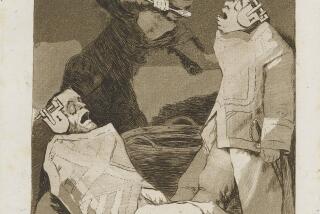The Ever-Changing Depiction of Mary Magdalene in Art
NEW YORK — Was she a sinner? A witness? A prostitute? A muse?
She is all of these things--or none of them. She might well have been a composite of different women.
But whoever the woman now known as Mary Magdalene was, her depiction in the Christian Gospels and in religious and secular art has exerted an unusually powerful influence over the Western imagination.
With the exception of Jesus and his mother, probably no other figure in the Gospel narratives has been so revered or so often the subject of devotion.
But Mary Magdalene’s place in the Christian tradition has also been enigmatic--and has resulted in portrayals ranging from sinner to saint, from “fallen woman” to figure of redemption.
“Who she is is almost impossible to say,” said scholar Diane Apostolos-Cappadona, co-curator of an exhibit, “In Search of Mary Magdalene: Images and Traditions,” now at the gallery of the American Bible Society in New York City.
“In Search of Mary” explores the ways in which Mary Magdalene has been portrayed in the visual arts. The exhibit includes paintings, prints, sculptures, manuscript illustrations and even stills from such films as Cecil B. DeMille’s 1927 silent classic “The King of Kings.”
Though small in size, the exhibit explores its subject with a mixture of historical depth, theological grounding and a dash of “postmodern” intellectual investigation--inviting the question of what the various portrayals of Mary in visual art tell us about the societies that produced them.
“How she came to be formidable to explain entails an arduous journey,” Apostolos-Cappadona said in an essay, “through a matrix of oral and written traditions, theology, spirituality, ritual, mythology, art, culture, values, and the human psyche.”
Not to mention some murkiness at the beginning of the story.
Apostolos-Cappadona notes that there has been “a muddle of Marys”--the Christian Gospels mention at least seven Marys, three of them particularly well-known: Mary, the mother of Jesus; Mary of Bethany, the sister of Lazarus and Martha; and the Mary called Mary of Magdala, or Mary Magdalene.
The canonical Gospels emphasize different aspects of this Mary: Matthew, Mark and John describe her as standing at the foot of the cross; Luke says Mary was one of Jesus’ earliest followers; Mark and Luke portray her as the person from whom Jesus cast out seven demons.
All of the narratives describe her as one of the holy women who heard the announcement of Jesus’ resurrection, having first tried to anoint Jesus’ body; Matthew, Mark and John all portray her as the first witness to the resurrection. It is this portrayal that has perhaps most endeared her to artists and Christian believers.
But as the ABS exhibit makes clear, there have been numerous Mary traditions, and the depiction of Mary Magdalene changed with the course of church history.
Aside from her importance in the Gospel narrative as resurrection witness, Mary’s most important role in Christian tradition has been of penitential saint, as in Carlo Dolci’s “The Penitent Magdalene,” a 17th century oil painting depicting a tearful, haunted woman urgently praying to the heavens.
Differing Christian traditions also appropriated Mary: Catholic painters depicted her as a defender of Roman Catholic sacraments during the Counter-Reformation, while 16th century Flemish painters, feeling the tide of an emerging Protestant culture and wanting to downplay the importance of Mary, Jesus’ mother, chose to reemphasize Mary Magdalene’s penitence. Others opted to depict Mary Magdalene as a contemplative, as in a 1520 painting of Mary reading her prayer book.
Perhaps most striking are 19th century depictions of Mary as the “femme fatale.” In “Mary Magdalene at the House of the Pharisee” (1891), the French painter Jean Beraud depicts Mary as attired in an ornate gown and melodramatically kneeling at the foot of Jesus, surrounded by European captains of industry as they finish their dinner.
The 20th century has brought a variety of portrayals, including American Wendy Brusick Steiner’s “I’ve Seen Love Conquer the Great Divide” (1989), in which Mary Magdalene assumes the traditional pose of cradling the dead Jesus’ feet.
Apostolos-Cappadona, who teaches at Georgetown University, said in an interview that what makes Mary endlessly fascinating is the inherent mystery of the woman herself and “all of the layers we have placed on her through the centuries.”
To Christians, Mary Magdalene has been an “approachable figure,” she said. “Mary Magdalene is like the rest of us--not perfect--and in that sense is a model for faith.”
“She is like a mirror,” said Apostolos-Cappadona. “She has all of these dimensions and yet we still ask, ‘Who is she?’ ”
“In Search of Mary: Images and Traditions” continues through June 29 at the gallery of the American Bible Society. Its Web site is www.americanbible.org.
More to Read
The biggest entertainment stories
Get our big stories about Hollywood, film, television, music, arts, culture and more right in your inbox as soon as they publish.
You may occasionally receive promotional content from the Los Angeles Times.










